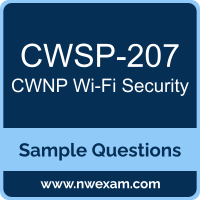 Before you write the CWNP Wi-Fi Security (CWSP-207) certification exam, you may have certain doubts in your mind regarding the pattern of the test, the types of questions asked in it, the difficulty level of the questions and time required to complete the questions. These CWNP Certified Wireless Security Professional (CWSP) sample questions and demo exam help you in removing these doubts and prepare you to take the test.
Before you write the CWNP Wi-Fi Security (CWSP-207) certification exam, you may have certain doubts in your mind regarding the pattern of the test, the types of questions asked in it, the difficulty level of the questions and time required to complete the questions. These CWNP Certified Wireless Security Professional (CWSP) sample questions and demo exam help you in removing these doubts and prepare you to take the test.
The best approach to pass your CWNP CWSP-207 exam is to challenge and improve your knowledge. To test your learning and identify improvement areas with actual exam format, we suggest you practice with Premium CWNP CWSP-207 Certification Practice Exam. The practice test is one of the most important elements of your CWNP Wireless Security Professional (CWSP) exam study strategy to discover your strengths and weaknesses, to improve your time management skills and to get an idea of the score you can expect.
CWNP CWSP-207 (CWSP) Sample Questions:
01. Which of these attacks are considered denial-of-service attacks?
(Choose two.)
a) Man-in-the-middle
b) Jamming
c) Deauthentication spoofing
d) MAC spoofing
e) Peer-to-peer
02. The CCMP header is made up of which of the following pieces?
(Choose two.)
a) PN
b) TTAK
c) TSC
d) Key ID
e) MIC
03. What are some the components within an MDM architecture?
(Choose all that apply.)
a) AP
b) RADIUS
c) BYOD
d) APNs
e) GCM
04. Which of these types of EAP use three phases of operation?
a) EAP-TTLS
b) EAP-PEAPv0 (EAP-MSCHAPv2)
c) EAP-PEAPv0 (EAP-TLS)
d) EAP-FAST
e) EAP-TLS (privacy mode)
f) EAP-TLS (nonprivacy mode)
05. You must locate non-compliant 802.11 devices. Which one of the following tools will you use and why?
a) A spectrum analyzer, because it can show the energy footprint of a device using WPA differently from a device using WPA2.
b) A spectrum analyzer, because it can decode the PHY preamble of a non-compliant device.
c) A protocol analyzer, because it can be used to report on security settings and regulatory or rule compliance.
d) A protocol analyzer, because it can be used to view the spectrum energy of non-compliant 802.11 devices, which is always different from compliant devices.
06. How are IPsec VPNs used to provide security in combination with 802.11 WLANs?
a) Client-based security on public access WLANs
b) Point-to-point wireless bridge links
c) Connectivity across WAN links
d) All of the above
07. When deploying a corporate 802.11 WLAN, what password-related items should always be included in a security policy?
(Choose two.)
a) The password policy should mandate a procedure on how passphrases are created for handheld devices that use WPA2-Personal.
b) End-user WPA2-Enterprise passwords should contain numbers, special characters, and upper- and lowercase letters.
c) Client-side certificates should always be used instead of passwords when securing a WLAN.
d) Machine authentication should always be mandated.
08. What would be the intended purpose of using a third-party AP as part of a WLAN audit?
a) Audit the WIPS.
b) Audit the wired infrastructure.
c) Audit Layer 2.
d) Audit Layer 1.
09. At which layer of the OSI model does 802.11 technology operate?
a) Session
b) Network
c) Physical
d) Presentation
e) Transport
10. With a WLAN infrastructure, where can the guest captive web portal operate?
a) AP
b) WLAN controller
c) Third-party server
d) All of the above
Solutions:
|
Question: 01
Answer: b, c
|
Question: 02
Answer: a, d
|
Question: 03
Answer: a, d, e
|
Question: 04
Answer: d
|
Question: 05
Answer: c
|
|
Question: 06
Answer: d
|
Question: 07
Answer: a, b
|
Question: 08
Answer: a
|
Question: 09
Answer: c
|
Question: 10
Answer: d
|
Note: If you find any error in these CWNP Wireless Security Professional (CWSP) sample questions, you can update us by write an email on feedback@nwexam.com.
 Before you write the CWNP Wi-Fi Security (CWSP-207) certification exam, you may have certain doubts in your mind regarding the pattern of the test, the types of questions asked in it, the difficulty level of the questions and time required to complete the questions. These CWNP Certified Wireless Security Professional (CWSP) sample questions and demo exam help you in removing these doubts and prepare you to take the test.
Before you write the CWNP Wi-Fi Security (CWSP-207) certification exam, you may have certain doubts in your mind regarding the pattern of the test, the types of questions asked in it, the difficulty level of the questions and time required to complete the questions. These CWNP Certified Wireless Security Professional (CWSP) sample questions and demo exam help you in removing these doubts and prepare you to take the test.